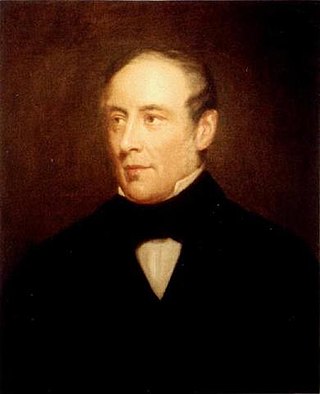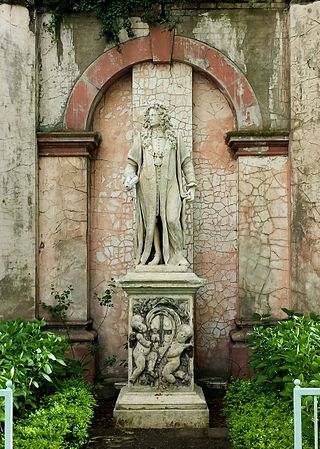Related Research Articles

The South Sea Company was a British joint-stock company founded in January 1711, created as a public-private partnership to consolidate and reduce the cost of the national debt. To generate income, in 1713 the company was granted a monopoly to supply African slaves to the islands in the "South Seas" and South America. When the company was created, Britain was involved in the War of the Spanish Succession and Spain and Portugal controlled most of South America. There was thus no realistic prospect that trade would take place, and as it turned out, the Company never realised any significant profit from its monopoly. However, Company stock rose greatly in value as it expanded its operations dealing in government debt, and peaked in 1720 before suddenly collapsing to little above its original flotation price. The notorious economic bubble thus created, which ruined thousands of investors, became known as the South Sea Bubble.

The Panic of 1837 was a financial crisis in the United States that began a major depression, which lasted until the mid-1840s. Profits, prices, and wages dropped, westward expansion was stalled, unemployment rose, and pessimism abounded.

The Royal African Company (RAC) was an English trading company established in 1660 by the House of Stuart and City of London merchants to trade along the West African coast. It was overseen by the Duke of York, the brother of Charles II of England; the RAC was founded after Charles II ascended to the English throne in the 1660 Stuart Restoration, and he granted it a monopoly on all English trade with Africa. While the company's original purpose was to trade for gold in the Gambia River, as Prince Rupert of the Rhine had identified gold deposits in the region during the Interregnum, the RAC quickly began trading in slaves, which became its largest commodity.

The Slavery Abolition Act 1833 was an Act of the Parliament of the United Kingdom which provided for the gradual abolition of slavery in most parts of the British Empire. It was passed by Earl Grey's reforming administration and expanded the jurisdiction of the Slave Trade Act 1807 and made the purchase or ownership of slaves illegal within the British Empire, with the exception of "the Territories in the Possession of the East India Company", Ceylon, and Saint Helena. The Act came into force on 1 August 1834, and was repealed in 1998 as a part of wider rationalisation of English statute law; however, later anti-slavery legislation remains in force.

George Fife Angas was an English businessman and banker who, while residing in England, played a significant part in the formation and establishment of the Province of South Australia. He established the South Australian Company and was its founding chairman of the board of directors.

Thomas Bennett Jr. was an American businessman, banker and politician, the 48th Governor of South Carolina from 1820 to 1822. A respected politician, he had served several terms in the state legislature since 1804, including four years as Speaker of the House, and a term in the state Senate.

Bristol, a port city in south-west England, was involved in the transatlantic slave trade. Bristol's part in the trade was prominent in the 17th and 18th centuries as the city's merchants used their position to gain involvement. It is estimated that over 500,000 enslaved African people were traded by Bristol merchants.

Beeston Long, of Combe House, Surrey, was an English businessman.

Levi Woodbury was an American attorney, jurist, and Democratic politician from New Hampshire. During a four-decade career in public office, Woodbury served as Associate Justice of the Supreme Court of the United States, a United States Senator, the ninth governor of New Hampshire, and cabinet member in the Andrew Jackson and Martin Van Buren administrations. He was promoted as a candidate for the Democratic nomination for President of the United States in 1848.
Sir John Rae Reid, 2nd Baronet (1791–1867) was a Scottish merchant and financier. He was a Tory and Conservative politician who sat in the House of Commons between 1830 and 1847.
Thomson Hankey was a British merchant, a banker and a Liberal Party politician.
John Horsley Palmer was an English banker and Governor of the Bank of England.
Benjamin Buck Greene was a British banker, plater, and financier. He inherited a large fortune derived from the Atlantic slave trade and the sugar industry in the Caribbean, later becoming one of London's leading merchants and shipowners. He served as a director of the Bank of England for fifty years from 1850, also serving as deputy governor (1871-3) and governor (1873–5).
Jeremiah Harman was chief of a family known in the commercial world for nearly a century, and highly esteemed both in England and abroad. He may himself be said to have stood at the head of London city, both as to mercantile and private character; liberal in his dealings, and inspiring confidence by his honor and integrity, as well as love for his personal qualities. As a public character Mr. Harman was known to all the ministers of the day, from William Pitt Jr downwards.
Daniel Giles was a London merchant and banker, the son of Huguenot immigrant parents.
James Pattison was Governor of the Bank of England from 1834 to 1837. He had been Deputy Governor from 1833 to 1834. He replaced Richard Mee Raikes as Governor and was succeeded by Timothy Abraham Curtis.
Sheffield Neave (1799–1868) was an English merchant and Governor of the Bank of England from 1857 to 1859.

Bonamy Dobrée was Governor of the Bank of England from 1859 to 1861. He had been Deputy Governor from 1857 to 1859. He replaced Sheffield Neave as Governor and was succeeded by Alfred Latham. In June 2020 the Bank of England issued a public apology for the involvement of Dobrée, amongst other employees, in the slave trade following the investigation by the Centre for the Study of the Legacies of British Slave-ownership at UCL.

Alfred Latham (1801–1885) was an English businessman and banker, born in Camberwell to Thomas Latham (1746–1818), a merchant and plantation owner, and his wife, Ann Jones. Inheriting wealth, Latham went into business in 1824, and went into partnership in what became the Arbuthnot Latham bank in 1833, with John Alves Arbuthnot (1802–1875).

The statue of Robert Clayton stands at the entrance to the North Wing of St Thomas' Hospital, Lambeth, London. The sculptor was Grinling Gibbons, and the statue was executed around 1700–1714. Sir Robert was a banker, politician and Lord Mayor of London. As President of St Thomas', he was responsible for the complete rebuilding of the hospital, and associated church in the late 17th century. The statue was designated a Grade I listed structure in 1979.
References
- ↑ Governors of the Bank of England. Bank of England, London, 2013. Archived here. Retrieved 21 March 2016.
- ↑ "Bank of England apologises for role of former directors in slave trade". The Guardian. 18 June 2020. Retrieved 19 June 2020.